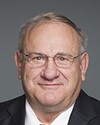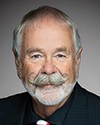Thank you, Madam Chair, committee members.
Thank you for inviting Nature Canada to speak to the committee. It's an honour to be here. My name is Eleanor Fast, and I am executive director of Nature Canada. I'm joined here today by my colleague Alex MacDonald, senior conservation manager.
Nature Canada is the oldest national conservation charity in Canada. Since our founding is 1939, we've been working to protect habitats and the species that depend on them, as well as connecting Canadians to nature. Nature Canada is the national voice for nature, representing 45,000 members and supporters and a network of provincial and local nature organizations across Canada.
We are thrilled that the committee is undertaking this study on protected areas. Canada has a rich natural resource of forests, freshwater and marine habitats, and grasslands that make a significant contribution to the world's ecosystem services. Many of Canada's wild spaces remain intact and to some degree connected at the landscape level, but action must be swift in order to conserve this biodiversity for generations to come.
One component of this protection must be the designation of areas protected for biodiversity, for wildlife conservation, given the threatened status of many species and the still poorly understood impacts of climate change on wildlife populations.
Canada urgently needs a comprehensive implementation strategy for protected areas in order to achieve the Aichi targets and to arrive at a long-term vision. To reach our Aichi target goals of protecting 17% of Canada's land and 10% of our oceans by 2020, the federal government, provincial and territorial governments, indigenous governments, industry, and civil society must work hand in hand. The federal government has an important leadership and coordination role to play.
In the written brief that Nature Canada submitted, we have outlined five specific recommendations for the committee to consider. In the interests of time, I'm going to focus my remarks on the first two recommendations, but Alex and I are happy to take questions on any of them.
Nature Canada's first recommendation is to ramp up efforts to establish new, and expand existing, national wildlife areas and migratory bird sanctuaries.
Environment and Climate Change Canada's Canadian Wildlife Service manages a network of over 12 million hectares of federally protected areas for wildlife conservation—the national wildlife areas and migratory bird sanctuaries. These areas are there to protect wildlife populations, particularly migratory birds and species at risk. They are often overlooked as protected areas, but they are important and currently comprise about 11% of terrestrial and marine protected areas, second only to Parks Canada, and they encompass more marine areas than the Department of Fisheries and Oceans' marine protected areas.
The network of national wildlife areas and migratory bird sanctuaries suffers from a low profile and significant threats to ecological integrity. The network is underfunded. Currently it receives about a dollar per hectare for the entire program and just 25¢ per hectare for site maintenance.
In the Green Budget Coalition's recommendations for the 2016 budget, $3 million was recommended to create three new national wildlife areas, and $10 million for management of existing sites, ramping up to $30 million annually by 2019. However, funding for new national wildlife areas was absent from the federal budget, even though relatively modest sums could make a huge impact.
As well as being relatively inexpensive, national wildlife areas and migratory bird sanctuaries are easier to create than national parks and offer more management flexibility, making them appealing in meeting the 2020 timeline of the Aichi targets.
Nature Canada and our partners have done significant work in identifying sites most in need of protection as national wildlife areas and migratory bird sanctuaries. With partners, we have recognized 600 important bird and biodiversity areas, IBAs, across Canada's diverse landscapes. We've built a comprehensive database, developed many site conservation plans, and developed a network of hundreds of volunteer stewards who conserve IBAs.
These sites provide a template for the expansion of national wildlife areas and migratory bird sanctuaries, and Nature Canada and our partners are ready to work with the federal government to help reach the Aichi targets and the long-term vision that is needed beyond that.
The second recommendation that we would like to make is simply to stop losing protected areas. Given Canada's commitment to the Aichi targets, transferring ecologically sensitive habitat that currently enjoys some protection into private hands without binding rules to protect ecological integrity simply does not make sense, yet the Government of Canada is currently in the process of transferring 700,000 hectares of native grasslands in 62 community pastures formerly managed by the prairie farm rehabilitation administration, or PFRA. The government is transferring them to the Government of Saskatchewan, which has stated that it intends to sell these lands once transferred.
Temperate grasslands are among the most endangered ecosystems in Canada and globally, and the federal community pasture program invested hundreds of millions of dollars over 80 years to restore and manage more than a million hectares of native grasslands. These community pastures are home to some of the highest concentrations of species at risk on the continent and 31 federally listed species at risk. This is an urgent issue, as many of these community pastures are scheduled to be transferred in 2017. Nature Canada recommends a pause while a strategy to protect these habitats and species at risk is developed.
That outlines the first two recommendations that we made in the brief. The other recommendations are these.
Recommendation three is to ensure that the Parks Canada Agency and the Department of Fisheries and Oceans have sufficient resources to meet their objectives for establishing new and expanded national parks, national marine conservation areas, and marine protected areas.
Recommendation four is to negotiate the establishment of new protected areas with indigenous governments as part of the nation-to-nation process that the federal government is committed to.
Recommendation five is to demonstrate federal leadership on the use of Aichi target 11, “other effective area-based conservation measures”, to protect important terrestrial and marine ecosystems in concert with the indigenous and local governments, private landowners, and non-governmental organizations responsible for their stewardship and management.
More details on these recommendations can be found in the written brief that Nature Canada submitted.
Thank you, again, for giving Nature Canada the opportunity to speak to the committee. Alex and I look forward to your questions.












